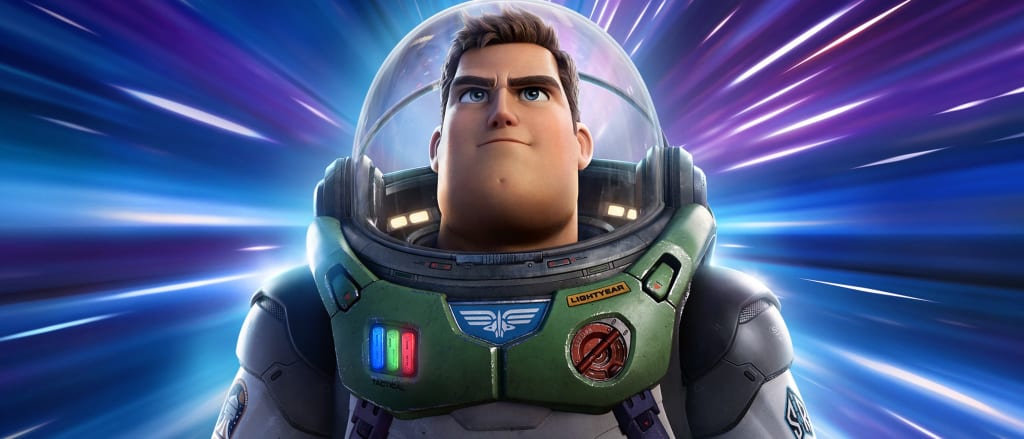Five Hard Sci-fi Elements Overlooked in Lightyear
A Movie Review

*****SPOILER ALERT IF YOU HAVE NOT WATCHED THE MOVIE*****
First, I want to say that Lightyear is a great family movie with fun and entertainment for all ages. But rather than do the typical movie review, I want to focus on some of the details that stood out to me, as both great details and things one would not expect from a more family.
If you’ve looked at any of my previous work, you know that two of my favorite genres are sci-fi and fantasy. However, I was surprised to see so many concepts pop up in a family movie that is not usually associated with hard science fiction. For those unfamiliar with the term, hard sci-fi is usually characterized being scientifically accurate and having a reasonable level of logic to the story. This is contrasted with soft sci-fi, which is usually more focused on the human experience of the characters, rather than scientific accuracy or a logic-based reality. Think of Star Wars vs Interstellar as reference points.
Here are the five that stood out the most to me:
1. Subspace Travel

1. Hyperspace Travel
Lightyear begins with Buzz Lightyear and his crew exploring the planet T'Kani Prime. That is until the planet’s fauna begins attacking them, forcing an emergency retreat. During their attempted escape, Buzz is forced to crash land the ship. This causes Commander Hawthorne and Buzz Lightyear to wake the rest of the crew and settle on the planet while making repairs to their ship. A major component of them repairing the ship to leave the planet is creating a new crystal that fuels their hyperspace travel. Each time they create a new crystal, Buzz volunteers to pilot the test flight.
This was a very interesting element to watch in a family movie, as such things are often mentioned, but never shown to the extent that they are in Lightyear. The character's quest for a new hyperspace crystal is central to the plot, and also leads to the next hard sci-fi element.
2. Time dilation

Time dilation is the effect that object “A” will experience a difference in the amount of time passed relative to object “B”, due to differences in the velocity of each object relative to each other. In Lightyear, this is represented by Buzz only experiencing a four-minute flight, relative to the four years that have elapsed on T'Kani Prime while he was away. This is due to Buzz moving at a velocity, presumably light speed, that is about one light minute per year on T'Kani Prime. We come to this conclusion as the story tells us that a four-minute flight equals four years on T'Kani Prime.
However, neither the crew on T'Kani Prime nor Buzz knew this until after his first flight. But after his initial flight, the effects of time dilation become central to the story of Buzz and the crew on T'Kani Prime. This is due to Buzz continuing to go up each time they have a new hyperspace fuel formulated. But after he comes back from each flight, he is greeted by an ever-increasing amount of change on T'Kani Prime.
3. Sentient AI

To help him cope with these changes, Buzz is given a robotic cat named Sox. While this seems like a logical thing to do from the standpoint of curbing loneliness, as is Sox’s stated mission, what Sox represents is much more. The creators of Sox (both real and fictional) could have easily just made a robotic cat that would only interact the way real cats do. Yet, rather they created Sox with some sort of advanced A.I. that not only makes him self-aware, but also allows him to make decisions autonomously. This element of Sox leads to many hilarious moments. And at the same time, it represents one of the more plausible elements of sci-fi in the movie that may one day come to fruition.
4. Alternate realities

Alternate realities come in towards the end when it is revealed that Emperor Zurg is another Buzz Lightyear from an alternate timeline. While this only affects the in-movie universe, which itself is a movie within a movie. It does introduce the concept quite interestingly, as this alternate Buzz has taken over the ship of the original Zurg. This alternate version of Zurg is used as a plot device to teach the main Buzz that it is never too late to change yourself for the better.
5. Temporal paradox
In the main Buzz’s encounter with the Zurg-Buzz, we are forced to question what is the real sequence of events in this movie universe. Is the Zurg-Buzz from an alternate reality from the main Buzz, or is he but one of many possible futures for the main Buzz? I find it interesting that Pixar would include such an existential question in a family movie. But I am also excited that there are studios out there that are willing to take the risk of introducing young audiences to such high-minded concepts earlier in life. And with the continuing slide towards scientific illiteracy, I hope to see more entertainment geared toward younger audiences grapple with such questions in the future.
Thank you for reading my work. If you enjoyed this story, there’s more below. Please hit the like and subscribe button, you can follow me on Twitter @AtomicHistorian, and if you want to help me create more content, please consider leaving a tip or a pledged subscriber.
More from this author:






Comments
There are no comments for this story
Be the first to respond and start the conversation.